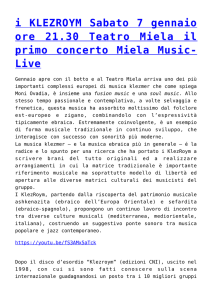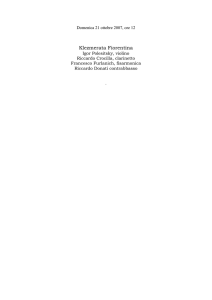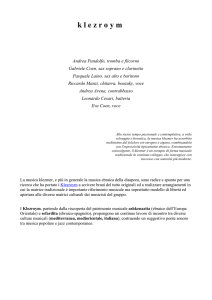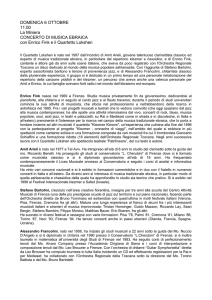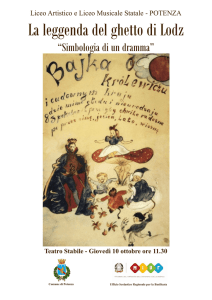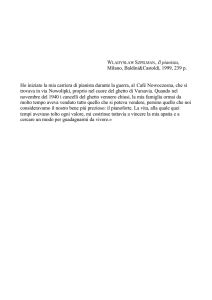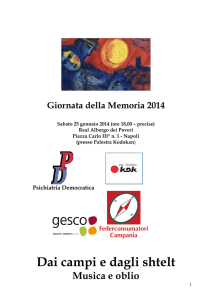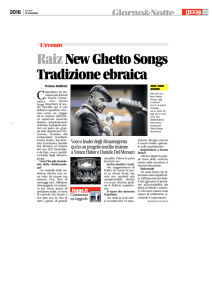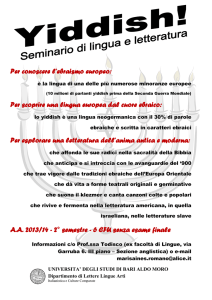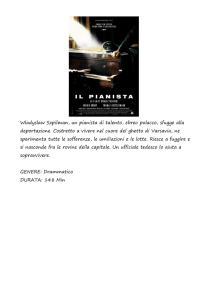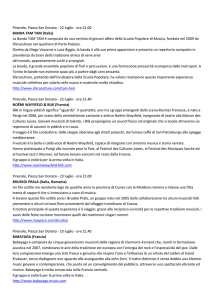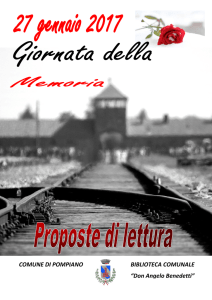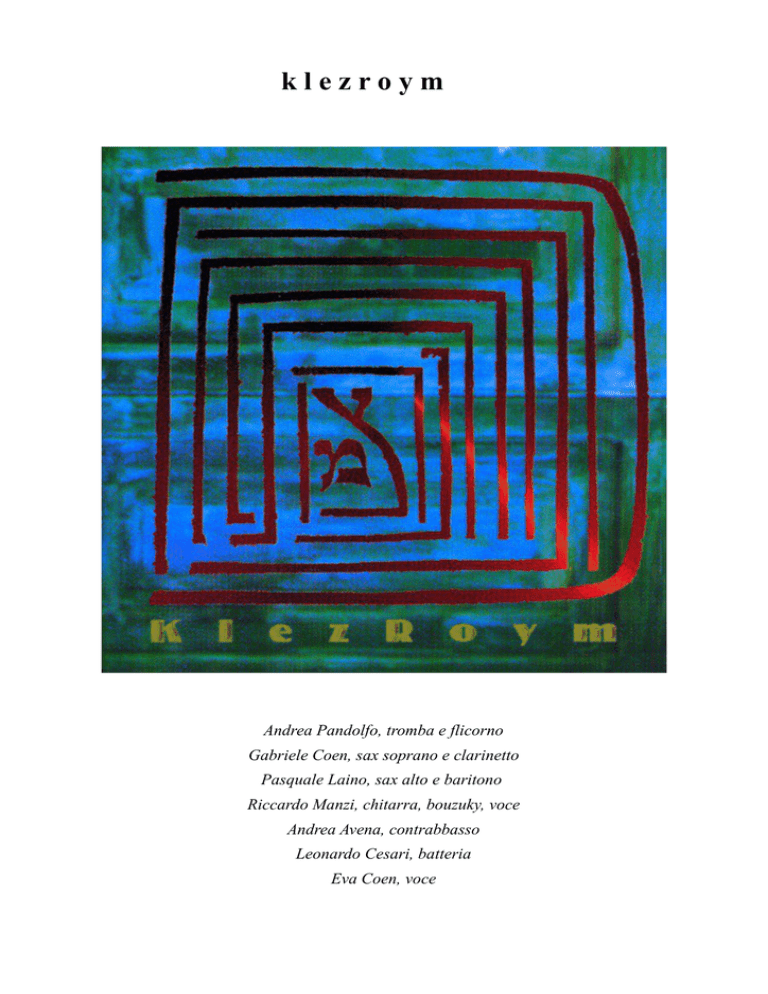
klezroym
Andrea Pandolfo, tromba e flicorno
Gabriele Coen, sax soprano e clarinetto
Pasquale Laino, sax alto e baritono
Riccardo Manzi, chitarra, bouzuky, voce
Andrea Avena, contrabbasso
Leonardo Cesari, batteria
Eva Coen, voce
Allo stesso tempo passionale e contemplativa, a volte
selvaggia e frenetica, la musica klezmer ha assorbito
moltissimo dal folclore est-europeo e zigano, combinandolo
con l'espressività tipicamente ebraica. Estremamente
coinvolgente, il klezmer è un esempio di forma musicale
tradizionale in continuo sviluppo, che interagisce con
successo con sonorità più moderne.
La musica klezmer, e più in generale la musica ebraica della diaspora, sono radice e spunto per una
ricerca che ha portato i Klezroym a scrivere brani del tutto originali ed a realizzare arrangiamenti in
cui la matrice tradizionale è importante riferimento musicale ma soprattutto modello di libertà ed
apertura alle diverse matrici culturali dei musicisti del gruppo.
I Klezroym, partendo dalla riscoperta del patrimonio musicale ashkenazita (ebraico dell’Europa
Orientale) e sefardita (ebraico-spagnolo), propongono un continuo lavoro di incontro tra diverse
culture musicali (mediterranea, mediorientale, italiana), costruendo un suggestivo ponte sonoro
tra musica popolare e jazz contemporaneo.
I Klezroym hanno al loro attivo:
5 dischi pubblicati con oltre 50.000 copie vendute;
circa 400 concerti in Italia e all’estero;
una triennale presenza – dal 2003 al 2005 – come gruppo stabile della trasmissione
televisiva di Rai 3 Dove osano le quaglie di Marco Presta e Antonello Dose;
l’ideazione e la realizzazione con Ascanio Celestini ed Olek Minzer dello spettacolo teatrale
Saccarina, cinque al soldo! rappresentato in tutti i maggiori teatri italiani.
I Klezroym propongono tre spettacoli
il Concerto in cui i klezroym presentano la sintesi del lavoro di ricerca ed elaborazione
fatto nei 15 anni di vita del gruppo;
Yankele nel ghetto, l'interpretazione originale ed inedita dei canti del ghetto di Lodz in
Polonia raccolti da Gila Flam nel libro “Singing for survival, songs of the Lodz ghetto” .
Yankele nel ghetto si presenta come una suite organica in cui la sequenza dei brani risponde
ad una forte esigenza narrativa.
La lettura in musica Saccarina 5 al soldo!
Ascolti
KLEZROYM various video
Biografia
Dopo il disco d'esordio Klezroym (edizioni CNI), uscito nel 1998, con cui si sono fatti conoscere
sulla scena internazionale guadagnandosi un posto tra i 10 migliori gruppi di musica klezmer del
mondo nella speciale classifica redatta in USA da Ari Davidoff per la rivista Klezmer Shack, il
gruppo romano nel 2000 ha pubblicato il secondo album Scenì (CNI). In esso prosegue
l'esplorazione nei territori della musica ebraica, senza trascurare le escursioni nel jazz
contemporaneo e nelle sonorità est-europee, nella musica mediterranea e nella canzone d'autore
italiana con la rilettura de la"Canzone dell'amore perduto" di Fabrizio De André.
Nel 2002 è stato pubblicato il loro lavoro Yankele nel ghetto (CNI), la rilettura originale ed inedita
delle Canzoni del ghetto di Lodz, ritrovate e raccolte da Gila Flam nel libro "Singing for survival,
Songs of the Lodz Ghetto, 1940-45" direttrice del Dipartimento di Musica e della Fonoteca di Stato
di Gerusalemme.
Sono le canzoni che la gente del ghetto di Lodz cantava negli anni durissimi dell'oppressione
nazista della Polonia. Raccontano un umanità cui la fame e la morte, la disperazione e i soprusi
non hanno tolto la capacità di sognare, di irridere i potenti e gridare all'ingiustizia.
"Yankele nel ghetto" è dedicato a tutti i popoli che ancora oggi soffrono la perdita della liberta’
vedendo calpestati i loro più elementari diritti.
Da Yankele nel ghetto i KlezRoym hanno ideato e realizzato con Ascanio Celestini e Olek
Mincer lo spettacolo teatrale Saccarina, cinque al soldo! che, insieme, hanno portato in tutti i
più importanti teatri italiani nella stagione 2001/2002.
Nel 2003 è stato pubblicata la compilation Klezroym (elleu, CNI) per la collana Sconfini.
I Klezroym sono stati per tre anni – dal 2003 al 2005 - gruppo stabile della trasmissione
televisiva di RAITRE Dove osano le quaglie di Marco Presta e Antonello Dose.
Nel 2006 sempre con le edizioni CNI hanno pubblicato il disco live Klezroym, venticinque
aprile live in Fossoli.
Due brani contenuti nell’album di esordio Klezroym, sono stati scelti per la colonna sonora di
“Once We Were Strangers”, primo lungometraggio di Emanuele Crialese.
La trasmissione di Rai 2 ,Sorgente di vita dedicata all’ebraismo e alla cultura ebraica, ha più volte
proposto nel corso degli anni dei servizi dedicati all’attività artistica del gruppo.
I Klezroym Hanno svolto centinaia di concerti in tutta Italia esibendosi nei contesti più disparati,
dai centri sociali ai templi della musica classica come il Teatro Regio di Torino e la Cappella
Paolina del Quirinale, nonchè all’estero (Spagna, Israele, Belgio). Hanno partecipato all’edizione
2003 del concerto del Primo Maggio a Piazza San Giovanni, Roma, gremita da 700.000 persone.
Concerti ed attività in evidenza
1997 - Klezmer Festival a Safed (Israele);
1998 - Stadio Olimpico di Roma con la partecipazione di Angelo Branduardi;
2000 - Tournèe in Spagna;
2001 - Napoli, l’Albergo dei Poveri, in occasione della commemorazione della prima “Giornata
Europea della Memoria della Shoa” con il progetto dedicato Yankele nel Ghetto alla presenza
dell’allora Presidente della Camera dei Deputati Luciano Violante ;
- Sala A di via Asiago, per RadioTre: diretta dello spettacolo Saccarina 5 al soldo!;
- Tourneè teatrale nei principali teatri Italiani con lo spettacolo Saccarina 5 al soldo di Klezroym e
Ascanio Celestini, con Klezroym, A. Celestini, Olek Minzer, Laura Polimeno;
2003 - Teatro Regio di Torino, Yankele nel ghetto, giornata della memoria;
- Roma, Yankele nel ghetto, Cappella Paolina del Quirinale - concerto trasmesso in diretta per Rai
Radio3, I concerti del Quirinale;
- Concerto del Primo Maggio in Piazza San Giovanni, Roma;
- Roma, Cappella Paolina del Quirinale, concerto in direttta RAI Radio3 per la rassegna “I Concerti
del Quirinale”;
2003-2005 - Partecipazione, come gruppo stabile , alla trasmissione televisiva di RAITRE “Dove
osano Le Quaglie” di Antonello Dose e Marco Presta;
2005 - Bruxelles, Concerto nell’ambito della realizzazione del film documentario “Yiddish Soul” di
Natalie Ferretti e Turi Finocchiaro;
- Carpi, Ex campo Fossoli, concerto per il 25 aprile. Da questo concerto è stato realizzato il disco
live Klezroym, venticinque aprile live in Fossoli.
2007 - Roma, Auditorium Parco della Musica, sala Petrassi, Yankele nel ghetto;
2008 - Roccella Jonica, Jazz Festival;
2009 - Mestre, Venezia Jazz Festival;
- Spagna, Palma de Maiorca, Festival Musica Antiqua Mallorca;
2011 - Radio3, Teatri sonori, Saccarina 5 al soldo!;
2013 - Roma, Cappella Paolina del Quirinale, concerto in diretta RADIOTRE per la rassegna “I
Concerti del Quirinale”;
2014 - Varsavia, Polonia, Singera 11th Jewish Culture Festival , Saccarina 5 al soldo! con Olek
Mincer;
- Lodz, Treatr Nowy, Saccarina 5 al soldo! con Olek Mincer, commemorazione dei 70 anni dalla
liquidazione del ghetto.
Rassegna Stampa
Ari Davidow – "Klezmer Shack"
"Klezroym’s debut Cd is wonderful, almost psychedelic klez at times. At its best, it reminds me of
the Shirim/Naftule’s Dream album, with a near-perfect mix of traditional klezmer and the rest of the
musician’s rivers, now fused into something new and expressive of our time".
Ari Davidow - KlezmerShack
"I posted this to the main KlezmerShack page last week, but it's still an exciting album that people
should know about, even after it disappears "below the fold" on the KlezmerShack. Here's to a first
listening (and second and third) to "Sceni," by Italy's "Klezroym," a band about whom I got very
excited when their first release came out a few years ago. This second release, based on a quick first
hearing, continued that Klezmer/Jewish-music based improvisational framework that caused the
first album to stand out. Here, I think that they've gotten tighter. They also continue to feature the
exquisite voice of Eva Coen. Despite some annoyingly bland English lyrics to something called
"Klezmer Song," the band, and especially her voice take off on the rest of the recording. I draw
special attention to a very well-done eastern-sounding "Morenica." Clearly influenced by the
current high standard set by Israel's "Natural Gathering," (Ha Breira-Ha'tiv'it), KlezRoym still make
it their own." [GRADE: A]
Ari Davidow - KlezmerShack
"Opening with a few bars of "Vayl ikh bin a yidale" this tribute to the Jews of the Lodz Ghetto
consists of songs collected by Gila Flam. KlezRoym manages to take difficult material and to
present it in ways that we will all listen. Sometimes, as on the opening vocal, also by Yankele
Hershkowitz, the words are more spoken than sung: "It is our grief, it is our problem!...." This
magically intense album, including several pages of preface by Gila Flam, whose collection of
songs from the ghetto, Singing for survival: Songs of the Lodz Gheto, 1940-45 is the source of this
material.
Not since Ghetto Tango a few years ago have the words of the Ghettos under the Nazi occupation
and extermination been presented as compellingly. Differently from "Ghetto Tango," where the
material was presented as a cabaret, these songs are presented here in ways that try to make the
words and melodies sear, while making the music almost transparent. It is like listening to master
typographers (the point of good typography is to make the words clear while never distracting the
reader with thought of the typography) at their craft, just working in music. Yet, sometimes, it is the
music that conveys the emotion and mood, as in "Sakharin finf a marek" inspired by children
selling sacharin on street corners, or at the end of "Ikh fur in kletser kant", or as on the "Yankele nel
Ghetto #2," in which the constant clang clang clang of the muted cowbell create a sense of work
work work and of striving to create from exhaustion and endless industrial labor, music.
Klezroym is one of the few bands that I can imagine with the range of styles, and the musical skill
to tackle such a task. (Another is Brave Old World. I wish that they, too, would release their Lodz
Ghetto material.) In some ways, this material suits them more than the klezmer music, not so known
prior to recent decades in their native Italy, with which they began performing and recording. At the
same time, grappling with such material is one way in which an ensemble performing new Jewish
music today can assimilate the past, make it part of who the band is and what it does, and face the
future, never to forget. Part of the never forgetting is to read the words of the songs, to listen. The
words are bitter, sad, wise in things that humans should not have to know. They describe life that is
impossible to imagine. But they are not passive songs, nor are they songs of despair. From "Kalt: A
lidl fin lodzer getto 1945", sung by the exquisitely-voiced Eva Coen:
Cold.
I see closed railroad cars
speeding by all through
the night,
Where did they take you?
This is a such a world....
and then the music takes flight with a song written for a theatre review in the Ghetto, sounding
almost like a Yiddish Pentangle (the British folk-rock group of the '60s) in "Tsigayner Lid". Before
this sinks in, the group is playing "Vayl ikh bin a yidale," one of the most memorable songs
arranged by Mlotek and Cooper on "Ghetto Tango." Here, however, the band makes the song their
own and finds a different way to make the song powerful, and their own. Finally, having built up the
tension, the two singers begin to work back and forth together on "Papirosn" and Ver klapt du azoy
shpet bay nakht". Finally, the sad theatre song: "Nit kayn rozhinkes in nit hayin mandlen":
No raisins and no almonds,
your father has not gone
out trading
lu, lu, lu, my son,
lu, lu, lu my son.
Some bands have chosen to mix klezmer melodies with whatever, turned klezmer into something
like a musical spice. Others have focused on the '78s and an imagined or researched Eastern Europe
of yore, playing klezmer as it was, or it might have been. Other than their name, this album has
everything to do with Jewish folk tradition and continuity, and very little to do with klezmer, per se.
Klezroym make it clear here, more than ever before, that they are creating new Jewish music, and
doing it with sublety and skill that put them in the first rank of the best of new Jewish music bands.
In that sense, the band is also according this material the highest honor--carrying the words forward
to be heard by new generations, lest they never forget, and lest that part of whatever Jewish means
in our generation, or the next, be lost. This is an album that will be hard to find in the United States.
The band is Italian. Liner notes are in Italian and English. The music is universal, sweet, and
haunting. Make the effort. You will be richly rewarded."
Brendan Foreman - Greenmanreview
"This is a lesson that I find myself learning over and over again: Never, ever underestimate
humanity's ability to reconfigure venerable art forms into new, often strange objects. Just when I
thought I had klezmer pretty much pegged as a musical form, I get this CD in the mail.
KlezRoym is a band out of Italy who combine the fervor and stylings of klezmer with the
improvisation of Gypsy jazz and the feel of Mediterranean music. Sure, all klezmer, being the
hybrid genre that it is, has a little Gypsy, a little jazz, and maybe a little Mediterranean harmony.
But KlezRoym, a seven-person unit
consisting of Gabriele Coen, Andrea Pandolfo, Pasquale Laino, Riccardo Manzi, Marco Camboni,
Leonardo Cesari, and Eva Coen, add their own mixture of moxy, imagination, and excellent
improvisational skills to the music. The absence of any fiddles or clarinets and the emphasis on
saxophones, bouzoukis, and
trumpets give the music of KlezRoym a distinctly forthright, sultry sound.
From the beginning track, "Trokar Kazal, Trokar Mazal (Change Country, Change Fate)," a Latinflavored song about an Spanish exile pining for his homeland, we know we're in for a treat. Eva
Coen's singing is simultaneously sensual and mournful, which is echoed in the plaintive saxophones
and trumpet of Gabriele Coen, Pasquale Laino, and Andrea Pandolfo. The song meanders into an
extended instrumental, the arrangement of which easily recalls some of the 3 Mustaphas 3's best
work.
This is just the beginning -- literally. From here, KlezRoym prove how little they can sit still,
moving from the ska-flavored klezmer of "To East," which ends with a wonderfully discordant
guitar solo, to the melancholy Italian love song "Canzone Dell'Amour Perduto (Song of Lost
Love)," written by Fabrizio De Andrè, then onto the Jewish-Hungarian hora "Szol A Kakas Mar
(And the Cock Crow)."
Interspersed between many of these tracks are snippets of "Radio Freylach"'s. A "freylach"
(meaning "joy" in Yiddish) is a standard melody form in klezmer, like the czardas in Hungarian
music and the jig in the music from the Isles. The half-minute freylachs that KlezRoym uses here to
introduce their tracks are all traditional tunes, which they've recorded in mono, giving them an "oldtime radio" sound.
Guitarist and bouzouki player, Riccardo Manzi, gets to stretch his vocal chords in "Arum Dem
Fayer (Around the Campfire)." Its haunting melody runs counter to the gaiety of the lyrics about the
Gypsy life of song and dance. This ends abruptly to the klezmer and jazz hybrid sounds of the title
track "Sceni, Sceni."
Rather than just the almost standard sounds of Gypsy jazz that is often found within klezmer, one
can also hear some strains of the cool jazz that was pioneered by Miles Davis back in the late '50's.
KlezRoym fills the rest of the CD with just as various a selection of music from the dirge-like
"Nostalgia," which is immediately lightened up by the up-beat jazz improv of "Regalo Di Nozze,"
to "Klezmer Song," KlezRoym's own celebration of klezmer music, and the foreboding Sephardic
folk song, "Morenica." The CD
"officially" ends with the lullaby "Oyfn Pripetshik (At The Fireplace)," a popular children's song
which prisoners of the death camps of Europe would often sing to each other and thus has become a
symbol of the Shoah.
Rather strangely, there are two bonus tracks, old-style house versions of "Morenica" and "Oyfn
Pripetshek." They're a bit of a shock after the traditional sounds of the previous tracks, but they are
a transition back to more modern sounds.
There really is no way any self-respecting klezmer or Gypsy jazz lover would want to miss this CD.
Actually, anyone with a passing interest in traditional European music will find plenty to enjoy on
this CD."
"Alias" de "Il Manifesto"
"Il klezmer ha nei Klezroym, primo gruppo italiano del genere, una punta di diamante. Con il loro
terzo album, poi, ci troviamo di fronte a un piccolo capolavoro. 15 brani, alcuni originali altri
rielaborati, per raccontare la tragedia del ghetto di Lodz, primo ad essere costruito in Polonia nel
1940 e ultimo a essere liquidato nel 1944. Dei circa 270 mila ebrei rinchiusi dai tedeschi,
sopravvissero alle violenze e ai campi di concentramento appena 887. In un luogo di così grandi
sofferenze restava solo il canto: Yankele Hershkowitz era proprio uno dei cantanti più sensibili nella
comunità. Canti intrisi di dolore, strazio ma anche di malinconia alternati a rari momenti di gioia,
vengono riproposti ora dal sestetto con arrangiamenti rigorosi legati alla tradizione ma spruzzati di
jazz e intonati dalla voce alta e commossa di Eva Coen."
Giuseppe Videtti - Musica di Repubblica
"Le prime note dell'esordio discografico di questa formazione klezmer sono così struggenti, che
l'ascoltatore rimane aggrappato ai suoni come a un sogno."
Giuseppe Videtti - TrovaRoma, La Repubblica
"Queste danze dal sapore gitano, inventate da zingari e girovaghi geniali, rivivono senza accusare il
peso dei secoli nelle intriganti atmosfere venate di jazz dei KlezRoym"
Giuseppe Videtti – Musica di Repubblica
"Lavorando sulle canzoni di Yankele, i Klezroym - primo gruppo italiano di musica klezmer partito
dalla riscoperta del patrimonio musicale askenazita e sefardita - hanno inciso il loro capolavoro.
Non solo è lodevole lo straordinario lavoro di ricerca condotto dall'ensemble di Gabriele Coen, non
solo è avvincente e toccante la vicenda di Yankele, ma soprattutto è attuale, pulsante, coinvolgente,
toccante, persino stravolgente il risultato. Più ricco di un romanzo di mille pagine o di una
produzione di Spielberg, Yankele nel Ghetto convoglia rigore della ricerca e nuova sensibilità
interpretativa sullo stesso binario. Se non avete familiarità con la musica klezmer, immaginate
semplicemente canzoni struggenti, un jazz malinconico, un efficace cabaret mitteleuropeo, un'opera,
un album concept o una lunga suite appassionata. Mai come nelle canzoni di Yankele, la voce di
Eva Coen era stata così versatile e comunicativa. E raramente oggi un disco con 15 titoli merita di
essere ascoltato tutto.
"Io Donna" del "Corriere della Sera"
"Ispirato ai canti germinati nel ghetto ebraico di Lodz durante gli anni bui del nazismo è il
notevolissimo Yankele nel Ghetto dei romani Klezroym, superba formazione a cavallo tra musica
klezmer e jazz. Da non perdere".
Federico Scoppio – "Jam"
"Yankele nel Ghetto è un progetto estremamente complesso e fuori da schemi e preconcetti di
genere. E' l'elaborazione in forma musicale delle canzoni del ghetto di Lodz, raccolte nel testo della
musicologa Gila Flam. A più di mezzo secolo di distanza i Klezroym hanno ricostruito
musicalmente il volto sonoro di quelle canzoni, tingendole di sacro e irripetibile, con il loro modo,
sempre più unico, di suonare raccontando. le canzoni e gli strumentali dell'incisione servono a
individuare i contorni e i lineamenti dei tre volti dei protagonisti: il cantore di strada Yankele, la
giovane donna Miriam e David, direttore musicale del teatro. E il cerchio si chiude .
Questo non è un semplice disco di miscela tradizional-popolare dei Klezroym, ma un progetto che
mischia storia, letteratura, tragedia, sentimenti, emozioni...Musica.
Vincenzo Cerami - Musica di Repubblica
"… La dote maggiore di questi ragazzi sta proprio nella organizzazione dei concertati (basati
sull'affiatamento del gruppo), negli arrangiamenti e soprattutto nella struggente espressività dei loro
strumenti: contrabbasso elettrico, fiati, batteria, chitarra, buzuki e la voce incantatrice di Eva Coen.
Sono brani che rielaborano temi e musicalità ebraiche e zingare, canzoni e danze della ritualità
yiddish... Musica colta, di scatenata raffinatezza,ma in grado di costringere gli spettatori a
partecipare alla festa. Vien Voglia di ballare, di battere le mani, di cantare ..."
Paolo De Bernardin - Musica di Repubblica
"Nella difficile e anonima realtà culturale del nostro paese il secondo lavoro discografico dei
Klezroym arriva come una specie di cometa luminosa. Partendo dai colori sefarditi del brano
d'apertura e scorrendo lungo la tradizione dell'Europa dell'Est, il gruppo si cimenta con alcune
composizioni proprie che meritano davvero l'applauso per la maturità inventiva e per la sensibilità
esecutiva. E di notevole fattura sono anche tutti gli arrangiamenti dei tradizionali ripescati dalla
ricchissima letteratura popolare degli ebrei sparsi per il mondo. E hanno fatto davvero bene i sette
musicisti a rendere omaggio, in chiave klezmer, alla canzone popolare di Fabrizio De Andrè nella
delicata e suggestiva versione de La canzone dell'amore perduto
Un gran bel lavoro, insomma, degno di stare alla pari con le migliori formazioni klezmer
internazionali."
Sandro Cappelletto - La Stampa
"Nel cuore del precipizio ritmico, entra improvvisa una melodia morbida come una carezza: sono
gli influssi sefarditi, della Spagna arabizzata, del Nord Africa. E quando al gruppo si aggiunge
anche Massimo Coen, e il suo violino adesso vola come un personaggio di Chagall, diventa
esplicito il potere
tremendo di questa musica."
Pinotto Fava - RaiTre
"Richiami islamici, attraversamenti jazzistici, vibrazioni zingare, "zoppi andamenti balcanici,
approcci minimalisti: con i KlezRoym la remota, forte matrice ebraica si fa voce e respiro di un
mondo che cerca nuove identità e altri smarrimenti".

